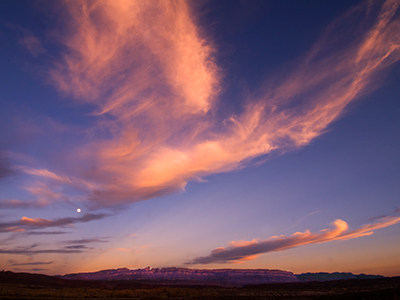 Over these still-unlit Colorado foothills, I watch a single cloud build like breath, an enormous pink wing buoyed by a sun that has not yet touched the valley floor to coax ravens into air, or turn creek water to fire, or hammer gold bars from the dull blades of my backyard windmill.
Over these still-unlit Colorado foothills, I watch a single cloud build like breath, an enormous pink wing buoyed by a sun that has not yet touched the valley floor to coax ravens into air, or turn creek water to fire, or hammer gold bars from the dull blades of my backyard windmill.
The cloud glows like that roseate spoonbill I saw slip down from a late afternoon in Tampa when I last visited my mother. The spoonbill joined other sun-holding birds settling on her pond. Its stick legs high-stepped in murky water. Its head swept side to side, refusing the carp that lolled in bottom muck, refusing whatever fading version of itself looked back from the calm surface, before it grew still to stand all night in six inches of water, safe from raccoons and notions of its own extinction.
Come morning, my mother led me to her screened-in porch. Bent inside from years of arthritis and widowhood, but standing straight, holding in her gnarled fingers a fine-boned cup of coffee, she pointed to the water and named each bird she’d learned to welcome to her long indoor life: great blue heron, anhinga, snowy egret, glossy ibis, wood stork, spoonbill—Gulf Coast comeback stories, every one, preparing to fly.
Now, on my birthday, I recall that morning, the birds, in their slow-feathered leaving, lifting from her pond, as I wish pain would lift from her tiny body and breathe shape to a high cloud that will grow, then dull, then wisp away.
—
John Calderazzo teaches nonfiction writing at Colorado State University and has appeared in Audubon, Bellevue Literary Review, Georgia Review, North American Review, Orion, and elsewhere. His most recent book is Rising Fire: Volcanoes and Our Inner Lives, a personal travelogue, which looks at ways in which volcanoes around the world have affected human culture.
Photo by Ryan Rodgers

1 comment
Charles Duell says:
Feb 16, 2025
Professor Calderazzo was new to CSU when I was in his creative writing class in the previous century. I came across this essay after googling his name.